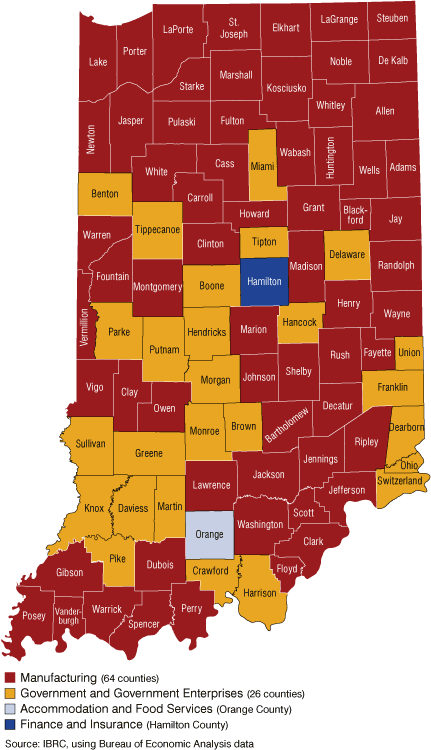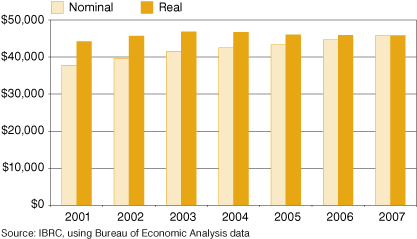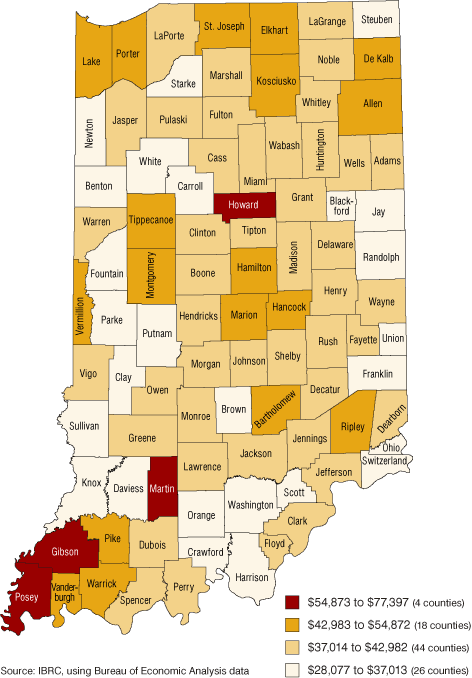Manufacturing Drove Indiana Compensation in 2007
Compensation for Indiana workers grew 3.1 percent in 2007, slightly outpacing inflation. This compares to growth of 3.4 percent in the Great Lakes region1 and 5.2 percent growth in the United States as a whole.
Manufacturing Led the Pack in 2007
Despite Indiana's diversification away from manufacturing, that sector still ranked number one in share of total compensation (see Table 1) in 2007 (the latest year for which federal data are available). More than one-quarter of all Indiana's nonfarm compensation flowed out of that sector, followed by government at 15 percent. The fastest growing sector, however, was professional and technical services, with an 8.2 percent growth.
Table 1: Indiana's Compensation by Industry, 2007
| Rank | Industry | Compensation (in Thousands) | Share of Total Nonfarm Compensation | Percent Change, 2006-2007 |
| 1 | Manufacturing | 36,962,044 | 26.1% | 0.1% |
| 2 | Government and Government Enterprises | 21,780,476 | 15.4% | 3.8% |
| 3 | Health Care and Social Assistance | 14,909,046 | 10.5% | 5.1% |
| 4 | Retail Trade | 8,962,439 | 6.3% | 1.2% |
| 5 | Construction | 8,348,004 | 5.9% | 6.6% |
| 6 | Wholesale Trade | 7,778,635 | 5.5% | 5.0% |
| 7 | Finance and Insurance | 6,557,105 | 4.6% | 0.9% |
| 8 | Professional and Technical Services | 6,156,494 | 4.4% | 8.2% |
| 9 | Transportation and Warehousing | 5,701,462 | 4.0% | 3.0% |
| 10 | Administrative and Waste Services | 4,757,514 | 3.4% | 5.5% |
| 11 | Other Services (except Public Administration) | 4,351,255 | 3.1% | 4.6% |
| 12 | Accommodation and Food Services | 3,759,700 | 2.7% | 3.3% |
| 13 | Management of Companies and Enterprises | 2,420,466 | 1.7% | 3.9% |
| 14 | Information | 2,299,441 | 1.6% | 4.4% |
| 15 | Educational Services | 1,779,146 | 1.3% | 5.9% |
| 16 | Arts, Entertainment and Recreation | 1,635,884 | 1.2% | 3.9% |
| 17 | Real Estate, Rental and Leasing | 1,407,856 | 1.0% | 0.8% |
| 18 | Utilities | 1,323,473 | 0.9% | 2.2% |
| 19 | Mining | 475,037 | 0.3% | 5.4% |
| 20 | Forestry, Fishing, Related Activities and Other | 102,239 | 0.1% | 7.7% |
Figure 1 shows the sector with the largest share of total compensation by county. Manufacturing had the largest share in 64 of Indiana's 92 counties. Government ranked first in 26 counties, bearing in mind that this sector includes compensation at public schools, public hospitals and the like.
Figure 1: Industry Sector with the Largest Share of Total Compensation by County, 2007

Average Compensation per Job
Average compensation per job helps explain these figures at the individual worker level. Figure 2 shows average compensation for the state in both nominal (actual) and real (adjusted for inflation) terms since 2001. While Indiana has experienced a steady increase in compensation in nominal terms, average compensation per job remained relatively stable after adjusting for inflation, with a slight peak in 2003.
Figure 2: Average Compensation in Indiana, 2001 to 2007

While the statewide average job compensation was $45,849, average compensation per job ranged from $28,077 in Brown County to $77,397 in Martin County (see Figure 3). With the presence of the Crane naval base, Martin County had the highest average compensation in the entire Great Lakes region.
Figure 3: Average Compensation per Job by Indiana County, 2007

Conclusion
The manufacturing sector will continue to be a vital source of jobs and wages in Indiana, as it has weathered significant business cycles over the past 60 years or more. Despite a very small nominal growth rate of 0.1 percent since 2006, manufacturing still accounts for more than 25 percent of nonfarm compensation in the state. Manufacturing is currently the dominant sector in 64 of 92 counties. Given the current recession and manufacturing's shifting fortunes, that reliance on manufacturing will pose significant challenges to our economies across the state.
Notes
Rachel Justis,
Geodemographic Analyst
Indiana Business Research Center, Kelley School of Business, Indiana University
